M777 howitzer
The M777 howitzer is a towed 155 mm artillery piece. It succeeded the M198 howitzer in the United States Marine Corps and United States Army in 2005. The M777 is also used by the ground forces of Australia, Canada, India and Saudi Arabia. It made its combat debut in the War in Afghanistan.
| M777 Lightweight Towed Howitzer | |
|---|---|
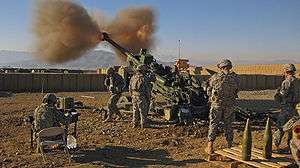 M777 Light Towed Howitzer in service with the 10th Mountain Division in Support of Operation Enduring Freedom, Logar Province, Charkh District, Afghanistan | |
| Type | Towed howitzer |
| Place of origin | United Kingdom |
| Service history | |
| In service | 2005–present |
| Used by | see "Operators" |
| Wars | War in Afghanistan (2001–present)[1] Iraq War Syrian Civil War[2] Iraqi Civil War (2014–17)[3] Yemeni Civil War (2015–present)[4] Saudi Arabian-led intervention in Yemen |
| Specifications | |
| Mass | 4,200 kg (9,300 lb)[5] |
| Length | Combat: 10.7 m (35 ft 1 in) Travel: 9.5 m (31 ft 2 in) |
| Barrel length | 5.08 m (16.7 ft)/L39 |
| Crew | 7+1 |
| Shell | M107, M795, ERFB, M982 |
| Caliber | 155 mm (6.1 in) |
| Carriage | Split trail |
| Elevation | 0° to +71.7°[6] |
| Rate of fire | Normal: 2 rpm Maximum: 5 rpm |
| Muzzle velocity | Charge 8S: 827 m/s (2713.25 ft/s) |
| Effective firing range | M107: 24 km (14.9 mi) ERFB: 30 km (18.6 mi) base bleed M795: 28.7–37 km (17.8- 23 mi) Excalibur: 40 km (25 mi) |
The M777 is manufactured by BAE Systems' Global Combat Systems division. Prime contract management is based in Barrow-in-Furness in the United Kingdom as well as manufacture and assembly of the titanium structures and associated recoil components. Final integration and testing of the weapon is undertaken at BAE's facility in Hattiesburg, Mississippi.[7]
Design

The M777 began as the Ultralight Field Howitzer (UFH), developed by Vickers Shipbuilding and Engineering's (VSEL) Armaments Division in Barrow-in-Furness, United Kingdom. VSEL was bought by BAE Systems after the UFH prototypes had been manufactured and demonstrated, consequently BAE became responsible for future design refinements and re-named the gun 'M777'. Upon taking-over responsibility for the weapon BAE to a large degree 'americanised' the construction and assembly through its US-based BAE Systems Land and Armaments group. The M777 now uses about 70% US-built parts including the gun barrel manufactured at the Watervliet Arsenal.[8]
With a weight of 4,200 kg (9,300 lb), the M777 is 41% lighter than the 7,154 kg (15,772 lb) M198 howitzer it replaces.[9][10] Much of the weight reduction is due to the extensive use of titanium.[11] The M777 can be transported by helicopter sling-load, transporter aircraft such as the C-130, or towed by air-braked vehicles weighing over 2.5 tonnes (2.8 short tons), such as the FMTV and MTVR.[12][13] The minimal gun crew required is five, compared to a previous nine.[14]
The M777 uses a digital fire-control system similar to that found on self-propelled howitzers such as the M109A6 Palladin to provide navigation, pointing and self-location, allowing it to be put into action quickly. The Canadian M777 in conjunction with the traditional "glass and iron sights/mounts" also uses a digital fire control system called the Digital Gun Management System (DGMS) produced by Leonardo MW with components of the Indirect Fire Control Software Suite (IFCSS) built by the Firepower team in the Canadian Army Land Software Engineering Centre.[15] The Leonardo MW portion of the system, known as LINAPS, had been proven previously through earlier fielding on the British Army Royal Artillery's L118 Light Gun.[16]
The Digital Fire Control System will be powered by a unique new design of rotary hybrid-electric engine designed and manufactured by Liquid Piston.[17]
The M777 may be combined with the M982 Excalibur GPS-guided munition, which allows accurate fire at a range of up to 40 km (25 mi). This almost doubles the area covered by a single battery to about 1,250 km2 (480 sq mi). Testing at the Yuma Proving Ground by the US Army placed 13 of 14 Excalibur rounds, fired from up to 24 kilometres (15 mi), within 10 m (33 ft) of their target, suggesting a circular error probable of 5 m (16 ft).[18]
In June 2012, Golf Battery, 2nd Battalion, 11th Marines, out of Camp Pendleton, California, dropped the M982 Excalibur round on insurgents at a range of 36 km (22 mi) in Helmand Province, Afghanistan. This marked the longest operational shot in the history of the M777 howitzer, and the longest operational tube artillery shot in history for the Marine Corps.[19]
In 2014 the US military began fielding several upgrades to its M777 howitzers including new liquid crystal display units, software updates, improved power systems, and muzzle sensors for onboard ballistic computing. Future upgrades include a touchscreen Chief Section Display, a new Mission System Computer, and a digital radio.[20]
In May 2017, the US Army revealed it was buying the Swedish BONUS round as an interim system as a result of the required phasing out of cluster munitions from artillery shells, complying with policy to achieve less than 1% unexploded ordnance from non-unitary explosives; the BONUS has two sensor-fused munitions deployed by a 155 mm carrier projectile that scan the ground for targets and fire explosively formed penetrators down from the air. The system has been tested from the M777 howitzer.[21]
| M777A2 | M198 | |
|---|---|---|
| Weight | 4,200 kg (9,300 lb) | 7,154 kg (15,772 lb) |
| Emplacement time | 2 min 10 s | 6 min 35 s |
| Displacement time | 2 min 23 s | 10 min 40 s |
| Number carried per C-130 Load | 2 | 1 |
| Crew complement | 5 | 9 |
Variants
- M777 – gun with optical fire control
- M777A1 – digitization upgrades with the addition of an on-board power source, satellite global positioning, inertial navigation, radio, Gun Display Unit (GDU) and Section Chief Assembly (SCA).
- M777A2 – Block 1A software upgrade. Addition of an Enhanced Portable Inductive Artillery Fuze Setter (EPIAFS) to enable Excalibur and precision munition compatibility.[22][23]
- M777ER – Upgrade created by the Extended Range Cannon Artillery (ERCA) project to extend range from 30 to 70 km (19 to 43 mi).[24] Modified with a longer 58-caliber, 30 ft (9.1 m) barrel and supercharged propellant firing the XM1113 rocket-assisted projectile.[25]
Service history
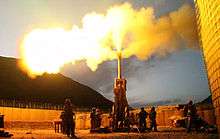

United States
Army
The 18th Field Artillery Brigade (Airborne) at Fort Bragg, North Carolina was the initial Army test bed unit for the XM777 which included the 1st and 3rd Battalions of the 321st Field Artillery Regiment. The initial prototypes were test by 1st Battations 377th Air Assault Regiment in 1998 also a unit of the 18th Field Artillery Brigade. 2nd Platoon, Bravo Battery, 2nd Battalion, 11th Field Artillery Regiment (2-11 FA) was the first US Army unit to fire the M777A in combat on 2 January 2008 in support of Operation Iraqi Freedom. In June 2007, the M777 in its A2 configuration was assigned to the U.S. Army's 3-321 FA. It deployed to Afghanistan in support of Operation Enduring Freedom in December 2007 in January 2008 making the unit the first U.S. Army unit to utilise the M777 in combat in support of Operation Enduring Freedom. In April 2008, the M777 was deployed for testing with 2-8 FA at Fort Wainwright in Fairbanks, Alaska.[26] On 20 July 2008, at Camp Shelby, Mississippi, 1-108 FA, 28th Infantry Division, Pennsylvania National Guard, became the first field artillery unit of the National Guard to field and fire the M777. Two soldiers from 2-319 FA were killed from a breech explosion and other members of their gun crew were injured while attempting to fire a M777 at an ISIL mortar position in northern Iraq.[27] Multiple firing incidents have occurred during training with the M777 including a fatal one in February 2014 with 3-321 FA[28] and previously in 2011 with Marines from Camp Lejeune also at Fort Bragg.[29]
The 3rd Cavalry Regiment deployed multiple M777A2 guns to Firebase Saham in Iraq on the border with Syria from 8 November 2018 to April 2019 to support the Syrian Democratic Forces in the Battle of Baghuz Fawqani, the ultimately successful operation to capture the final town held by ISIL.[30]
Marine Corps
In May 2005, 3rd Battalion, 11th Marines, based at Marine Corps Air Ground Combat Center Twentynine Palms, became the first Marine unit to begin fielding the new M777. 580 guns were supplied to the Marines, and 421 to the U.S. Army and National Guard.[31][32]
In March 2016, 200 Marines and four M777A2 howitzers from the 26th Marine Expeditionary Unit set up Firebase Bell, officially the Karasoar Counterfire Complex, near the Iraqi town of Makhmour, supporting the Iraqi Army's Mosul offensive. The firebase was only 15 miles (24 km) from ISIL-controlled territory, and one Marine was killed in a rocket attack on 19 March, just days after arriving; direct attacks on the base dropped off in the following weeks as the Iraqis captured surrounding villages. The Marine howitzers fired every day in support of Iraqi maneuvers, using high explosive, smoke, and illumination rounds.[33] They were relieved by Army soldiers after roughly 60 days, after firing more than 2,000 rounds in 486 fire missions.[34]
In March 2017, the 11th Marine Expeditionary Unit was deployed to Syria to provide artillery support with their M777s for forces seeking to eject ISIL forces from Raqqa.[35]
Australia
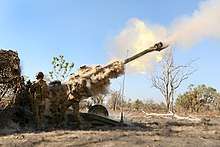
In 2008, the Australian Defence Force made a US Foreign Military Sales request for 57 M777A2s worth an estimated US$248m.[36] Subsequently, 35 guns were purchased for the Australian Army to re-equip the 1st Regiment, Royal Australian Artillery, the 4th Regiment, Royal Australian Artillery and the 8th/12th Regiment, Royal Australian Artillery to replace 155 mm M198s and 105 mm L119 Hamels.[37] The first deliveries of M777A2 began in late 2010.[38][39] An additional 19 guns will be bought directly from American production lines to enable a total of six batteries.[40] Concurrently, the Australian Army has acquired guided 155 mm munitions in the form of the M982 Excalibur and XM1156 Precision Guidance Kit.[41]
Brazil
In 2010, The Brazilian Navy evaluated the 155 mm M777 as a candidate to replace the six 155 mm M114A1 howitzers of the Marine Corps branch.[42] The successor to the M114 has not yet been chosen.
Canada
In December 2005, 1st Regiment, Royal Canadian Horse Artillery, conducted an inaugural firing of its first 155 mm M777 towed howitzers, for a total of six guns. The six guns delivered were supplied by the United States Marine Corps under a Foreign Military Sales (FMS) contract[43] between the U.S. and Canada. The Canadian guns were first fired by A Battery, 1 RCHA at CFB Shilo and then were deployed to Afghanistan in support of Operation Archer, and were put into service in the Canadian theatre of operations around Kandahar in early 2006, this marked the first use of the M777 in Combat operations. In the summer they made a significant contribution during the Battle of Panjwaii when a small number of rounds were used to huge effect on Taliban elements retreating from the battle area. Many of the 72 reported killed during the heaviest period of fighting were due to artillery fire from only two of these guns. In late fall of 2006, the Canadian M777 Howitzers were equipped with the Digital Gun Management System (DGMS), which greatly improved accuracy and led to these guns being used for Short Range Close Support of Canadian and US ground forces.[44] They proved so successful that an order for an additional six guns was placed with BAE. In May 2009, the Canadian government ordered a further 25 M777s, bringing the total to 37.[45][46] The DGMS is also being improved with integrated communications.[47]
India
The Indian Army first announced plans to acquire 145 guns for ₹30 billion (US$421 million),[48] but purchase plans were overtaken when the procurement process was restarted in July 2010. India's Ministry of Defence cleared the proposal for buying 145 guns for US$660 million on 11 May 2012 through the US Government's Foreign Military Sales (FMS) process.[49] This was put up before the Ministry of Finance for clearance and will subsequently be taken up by the Cabinet Committee on Security for final approval.[50][51] On 2 August 2013, India requested the sale of 145 M777 howitzers for US$885 million.[52] On 24 February 2014 the purchase was again postponed.[53] On 11 May 2014 the purchase was cleared by India's Defence ministry.[54] On 11 July 2014, the Government of India announced that it would not order the guns because of cost issues.[55] On 22 November 2014, the selection process was restarted under the "Make In India" program.[56] On 13 May 2015, The defence ministry approved ₹2,900 crore to buy 145 M777 ultralight howitzers from the US.[57] On 15 December 2015, the Indian Ministry of Defence said it was keen on placing a follow-up order of 500 more M777 guns.[58]
On 26 June 2016, it was announced that 145 guns will be purchased by India for US$750 million.[59] On 30 November 2016 Indian government completed the deal to buy 145 howitzers from the US.[60] The deal was completed in December 2016.[61] Under the agreement, BAE Systems supplied 25 ready-built howitzers, while 120 guns were manufactured in India by Mahindra Defence Systems Limited.[62]
The Indian Army received its first shipment comprising two howitzers on 18 May 2017 in New Delhi from United States in ready to use condition.[63][64] It was reported that on 2 September 2017, the barrel of one of the howitzers was damaged while firing during calibration trials.[65][66] The Indian army used the M777 howitzer in the Himvijay exercise in Arunachal Pradesh which involved the newly raised integrated battle groups.[67]
A total of 7 artillery regiments are planned, each of 18 guns. The first regiment is planned to be raised by end-2020 with 15 guns supplied by BAE systems and three guns supplied by Mahindra Defense Systems Limited.[68]
In July 2020, in the wake of escalating tension with China in light of hostile Chinese posturing, particularly on the border between the Union Territory of Ladakh and Chinese-occupied Tibet, further purchases of Excalibur shells were announced by the Indian Ministry of Defence.[69]
Saudi Arabia
In 2011, Saudi Arabia ordered 36 M777A2 155 mm towed howitzers from the United States, along with 17,136 rounds of high explosive (HE) ammunition and 2,304 rounds of longer range rocket assisted projectiles (RAPs).
The Saudis purchased HMMWV vehicles to haul ammunition and carry the crews and their gear. However, they did not order any GPS-guided 155 mm Excalibur shells for their M777A2 guns.[70]
Combat history
- Iraq War
- War in Afghanistan
- Military intervention against ISIL: Multiple M777A2 guns were deployed to Iraq on the border with Syria from 8 November 2018 to April 2019 to support the Syrian Democratic Forces in the Battle of Baghuz Fawqani, the ultimately successful operation to capture the final town held by the Islamic State group. They deployed to Firebase Saham, a base freshly constructed by the U.S. Army to provide fire support during the battle, especially during cloudy days when U.S. aircraft could not see to conduct airstrikes.[30]
Operators
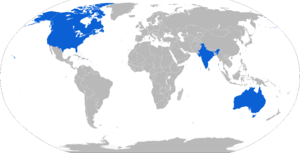
Current operators
.svg.png)
- 54 systems (M777A-2)
.svg.png)
- 37 systems

- 25 systems in service currently[71].(Total 145 System were on order out of which all the remaining 120 system are to be manufactured in India under the "Make in India" program)

- 70 systems

- 1,001 systems, 580 for the Marine Corps and 421 for the Army and Army National Guard, have been ordered.[31] Both the US Army and Marine Corps field a "pure fleet" of M777A2 variants.[20]
Potential operators

Gallery
- Canadian soldiers fire an M777 at Taliban fighting positions from a forward operating base in the Helmand Province
_lifts_an_M77.jpg) Sea Stallion helicopter lifts an M777
Sea Stallion helicopter lifts an M777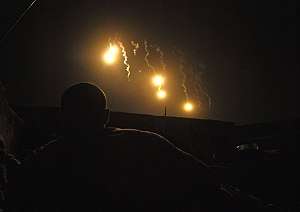 Illumination rounds fired during Operation Tora Arwa V in the Kandahar Province, Afghanistan
Illumination rounds fired during Operation Tora Arwa V in the Kandahar Province, Afghanistan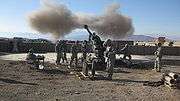 M777 in Logar Province, Afghanistan
M777 in Logar Province, Afghanistan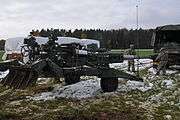 Towed configuration with the FMTV as the prime mover
Towed configuration with the FMTV as the prime mover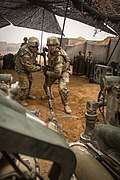 U.S. Army 3rd Cavalry Regiment using the ramming staff to load ammunition during the military intervention against ISIL in al-Qa'im, Iraq
U.S. Army 3rd Cavalry Regiment using the ramming staff to load ammunition during the military intervention against ISIL in al-Qa'im, Iraq
See also
- 152 mm howitzer 2A65
- AHS Krab
- List of howitzers
- SLWH Pegasus
- Norinco AH4 155mm Howitzer
References
- "Archived copy". Archived from the original on 11 January 2017. Retrieved 11 June 2017.CS1 maint: archived copy as title (link)
- https://www.youtube.com/watch?v=ceAWWIlNhNQ
- https://www.youtube.com/watch?v=93HFYz2LRoA
- "Archived copy". Archived from the original on 21 April 2015. Retrieved 11 June 2017.CS1 maint: archived copy as title (link)
- U.S. Upgrades and Orders More Lightweight BAE Systems Howitzers, BAE Systems, archived from the original on 10 July 2015, retrieved 9 July 2015
- John Pike. "M777 Lightweight 155mm howitzer (LW155)". Globalsecurity.org. Archived from the original on 4 November 2014. Retrieved 4 November 2014.
- "U.S. Upgrades and Orders More Lightweight BAE Systems Howitzers". Press release. BAE Systems – USA. 4 October 2011. Archived from the original on 7 October 2011. Retrieved 6 October 2011.
- "Waltervliet Arsenal Products PDF" (PDF). Retrieved 14 July 2019.
- "M777 Howitzer - Specifications". Canadian Army. 8 March 2013. Archived from the original on 3 August 2016. Retrieved 18 March 2017.
Weight: 4200 kg
- "M198 Towed Howitzer - Specifications". GlobalSecurity.org. Archived from the original on 1 April 2013. Retrieved 18 March 2017.
Weight: 15,758 pounds (7.154 kilograms)
- "M777 155mm Ultralightweight Field Howitzer". Army Technology. Archived from the original on 15 November 2016. Retrieved 18 March 2017.
The construction of the M777 makes extensive use of titanium and titanium castings, enabling a weight reduction of 3,175kg (7,000lb) compared to the M198 howitzer which it replaces in the US Army and USMC inventory.
- "M777 155mm Ultralightweight Field Howitzer". Army Technology. Archived from the original on 15 November 2016. Retrieved 18 March 2017.
The M777 has a production weight of 3,745kg and can be transported by helicopter, transporter aircraft and ship. The howitzer can be towed by an air-braked 4x4 vehicle greater than 2.5t.
- "M777 Howitzer - Specifications". Canadian Army. 8 March 2013. Archived from the original on 3 August 2016. Retrieved 18 March 2017.
The M777 weighs 9,200 pounds [...] making it highly mobile and easily transportable by C130 aircraft, helicopter or a truck of at least 2.5 tonnes.
- "M777 Lightweight 155 mm howitzer (LW155)". GlobalSecurity.org. Archived from the original on 26 May 2005. Retrieved 26 May 2005.
- "LSEC Firepower Team". dnd.ca. Retrieved 30 May 2017.
- "Army News article on the Canadian DGMS". forces.gc.ca. Archived from the original on 5 September 2012. Retrieved 30 May 2017.
- "LiquidPiston receives $3M Rapid Innovation Fund award from US Army for 2kW hybrid-electric genset". Archived from the original on 17 January 2018. Retrieved 16 January 2018.
- "Canada Deploys GPS Shell To Afghanistan". defensenews.com. Retrieved 4 November 2014.
- Lamothe, Dan (30 June 2012). "Long shot: Artillery battery sets lethal record". Marine Corps Times. Archived from the original on 12 October 2013. Retrieved 11 October 2013.
- "PM Towed Artillery Systems". Defense Media Network. Archived from the original on 5 November 2014. Retrieved 4 November 2014.
- "Army Concerned Over Ban on Cluster Munitions, Land Mines" Archived 6 August 2017 at the Wayback Machine Military.com, 2 May 2017
- Goldman, Harvey I. (12 June 2007). "LW155 Howitzer Towed Artillery Digitization" (PDF). NDIA Armaments Technology and Firepower Symposium 12 June 2007. dtic.mil. Archived from the original (PDF) on 13 September 2012. Retrieved 27 January 2013.
- Gooding, Keith; Kratzer, David (October–December 2008). "PEO GCS's Digitized Towed Howitzer Supports the GWOT" (PDF). Army Acquisition, Logistics, and Technology Magazine. US Army Acquisition Support Center. p. 32. Archived (PDF) from the original on 10 November 2013. Retrieved 27 January 2013.
- U.S. Army engineers work to create a new longer M777 155mm howitzer under the name M777ER Archived 25 March 2018 at the Wayback Machine. Army Recognition. 31 March 2016.
- US Army takes 40-mile shots from extended-range cannon in demo. Defense News. 6 March 2020.
- "Alaska in Brief—March 27" "Army to test new howitzer in Fairbanks", Fairbanks Daily News-Miner, 27 March 2008. Accessed 27 March 2008.
- "2 US soldiers killed in artillery mishap in Iraq identified". Archived from the original on 16 August 2017. Retrieved 18 August 2017.
- "82nd Airborne paratrooper dies in howitzer explosion at Fort Bragg". The Christian Science Monitor. Associated Press. 22 February 2014. Archived from the original on 5 November 2014. Retrieved 4 November 2014.
- "Ten injured during artillery training at Fort Bragg". WRAL.com. 15 March 2011. Archived from the original on 4 November 2014. Retrieved 4 November 2014.
- Welch, Jason (18 December 2018). "Firebase Saham: A day in the life of joint-artillerymen securing the Iraq border". www.army.mil. Archived from the original on 19 April 2019. Retrieved 19 April 2019.
- "DoD Orders 46 Additional M777 Howitzers". Deagel.com. 22 February 2011. Archived from the original on 9 July 2011. Retrieved 29 July 2012.
- "page:190" (PDF). Archived from the original (PDF) on 20 April 2011. Retrieved 28 February 2011.
- "Near ISIS front, U.S. Marine artillerymen 'fire every day'" Archived 18 August 2016 at the Wayback Machine Military Times, 7 April 2016
- "Marines in Iraq came under 'numerous' rocket attacks, commander says" Military Times, 30 June 2016
- "Marines have arrived in Syria to fire artillery in the fight for Raqqa". The Washington Post. 8 March 2017. Archived from the original on 9 March 2017. Retrieved 9 March 2017.
- "Australia – M777A2 155MM Light-Weight Howitzers" (PDF). Defense Security Cooperation Agency. 17 July 2008. Archived from the original (PDF) on 15 September 2012. Retrieved 12 September 2012.
WASHINGTON, July 17, 2008 – The Defense Security Cooperation Agency notified Congress of a possible Foreign Military Sale to Australia of M777A2 155MM Light-Weight Howitzers as well as associated equipment and services. The total value, if all options are exercised, could be as high as $248 million.
- "Boost in firepower" (PDF). Army: The Soldiers' Newspaper (1224). Canberra: Department of Defence. 29 October 2009. p. 2. ISSN 0729-5685. Retrieved 7 January 2020.
- Bergmann, Kym (23 October 2010). "Push is on to bring out the big guns". The Australian. News Ltd. Retrieved 4 January 2011.
- Kennedy, Lt-Col Mitch; Doran, LCpl Mark (3 March 2011). "Changes in artillery" (PDF). Army: The Soldiers' Newspaper (1253). Canberra: Department of Defence. p. 3. ISSN 0729-5685. Retrieved 7 January 2020.
- "Army to get more towed guns". news.com.au. AAP. 16 October 2012. Archived from the original on 16 October 2012. Retrieved 16 October 2012.
- FMS: Australia Requests Precision Guidance Kits for 155mm Munitions Archived 11 March 2014 at the Wayback Machine - Deagel.com, 12 August 2013
- "Marinha do Brasil interessada no obuseiro M777 da BAE Systems" [Brazilian Navy interested on BAE Systems' M777 howitzer]. Forças Terrestres - ForTe (in Portuguese). 19 September 2010. Archived from the original on 30 June 2017. Retrieved 19 March 2017.
- "FMS Contract Details". Archived from the original on 15 November 2016. Retrieved 4 November 2014.
- "Afghanistan News May 9, 2007". afghanistannewscenter.com. Archived from the original on 28 September 2007. Retrieved 11 July 2007.
- "BAE Wins $118m Orders for M777 Howitzer". defense-aerospace.com. Archived from the original on 4 November 2014. Retrieved 4 November 2014.
- "More howitzers on the way". forces.gc.ca. Archived from the original on 22 June 2013. Retrieved 30 May 2017.
- "M777 equipped with new digital gun management system". forces.gc.ca. Archived from the original on 29 May 2013. Retrieved 30 May 2017.
- Rajghatta, Chidanand (28 January 2010). "US okays howitzers worth $647 million for India". The Times of India. Archived from the original on 30 January 2010. Retrieved 30 January 2010.
- HP. "India Orders 145 M777 Ultra Light Howitzers From BAE Systems". Archived from the original on 5 November 2014. Retrieved 4 November 2014.
- "India clears $660 million deal for artillery guns". Economic Times. 11 May 2012.
- "Defence Ministry clears M777 howitzers procurement projects". DNA. 11 May 2012. Archived from the original on 13 May 2012. Retrieved 12 May 2012.
- FMS: India Requests Sale of 145 M777 155mm Light-Weight Towed Howitzers Archived 14 August 2013 at the Wayback Machine - Deagel.com, 7 August 2013
- Raghuvanshi, Vivek (24 February 2014). "India Postpones Purchase of 145 Ultra Light Howitzers". defensenews.com. Gannett Government Media. Retrieved 24 February 2014.
- "India buys new artillery guns, 27 years after Bofors". 11 May 2014. Archived from the original on 17 October 2014. Retrieved 26 May 2014.
- "Indian MoD says M777 buy in doubt over high cost, offset requirements". 13 July 2014. Archived from the original on 15 October 2014. Retrieved 12 September 2014.
- Pandit, Rajat (23 November 2014). "Three decades on, defence minister clears Rs 15,750 crore howitzer projects". Times of India. TNN. Archived from the original on 26 November 2014. Retrieved 22 November 2014.
- Govindan, Adarsh (14 May 2015). "New Aircraft Carrier, Brahmos Missiles, C-295 Planes & M-777 Howitzers all cleared for Purchase". defencenews.in. TNN. Archived from the original on 19 May 2015. Retrieved 13 May 2015.
- Basu, Nayanima (14 December 2015). "Ministry keen to purchase 500 more Howitzer guns from BAE Systems". The Hindu Businessline. Retrieved 30 May 2017.
- "India clears purchase of 145 ultra-light Howitzer guns from US". intoday.in. Archived from the original on 11 May 2017. Retrieved 30 May 2017.
- "M777 howitzer deal inked by the Indian government". 30 November 2016. Archived from the original on 1 December 2016. Retrieved 30 November 2016.
- Lal, Neeta (19 December 2016). "India Gets its Guns – 30 years late". Asia Sentinel. Archived from the original on 20 December 2016. Retrieved 21 December 2016.
- "Indian Army's M777 regiment to get 3 made-in-India guns". Hindustan Times. 13 November 2019. Retrieved 13 November 2019.
- "Army gets its first artillery guns three decades after Bofors, will be tested at Pokhran today". indianexpress.com. 18 May 2017. Archived from the original on 2 June 2017. Retrieved 30 May 2017.
- Peri, Dinakar (18 May 2017). "Two M777 Ultra-Light Howitzers arrive from U.S." The Hindu. Archived from the original on 18 May 2017. Retrieved 30 May 2017.
- "Army's new US-made M777 howitzer in trouble, barrel explodes at Pokhran range". 12 September 2017. Archived from the original on 12 September 2017. Retrieved 12 September 2017.
- "Barrel of US-manufactured Howitzer gun explodes during Indian army's calibration trial". Archived from the original on 12 September 2017. Retrieved 12 September 2017.
- "India China: India to deploy latest American weapon systems for Ex-HimVijay along China border - The Economic Times". m-economictimes-com.cdn.ampproject.org. Retrieved 14 October 2019.
- "Indian Army's M777 regiment to get 3 made-in-India guns - The Economic Times". m-economictimes-com.cdn.ampproject.org. 13 November 2019. Retrieved 13 November 2019.
- https://asiatimes.com/2020/07/border-clashes-prompt-india-to-fast-track-weapons-buys/
- "The Arabian Light". 7 October 2011. Archived from the original on 10 November 2013. Retrieved 5 May 2013.
- "BAE SYSTEMS TO SHOWCASE MAKE IN INDIA M777 HOWITZERS AT DEFEXPO". 28 January 2020.
To date, BAE Systems has produced and delivered 25 guns to the Indian Army, with another 70-plus planned for 2020.
- Binnie, Jeremy. "BAE Systems looks to sell M777 to the UAE". IHS Jane's 360. IHS Jane's. Archived from the original on 10 May 2016. Retrieved 9 May 2016.
External links
| Wikimedia Commons has media related to M777 howitzer. |